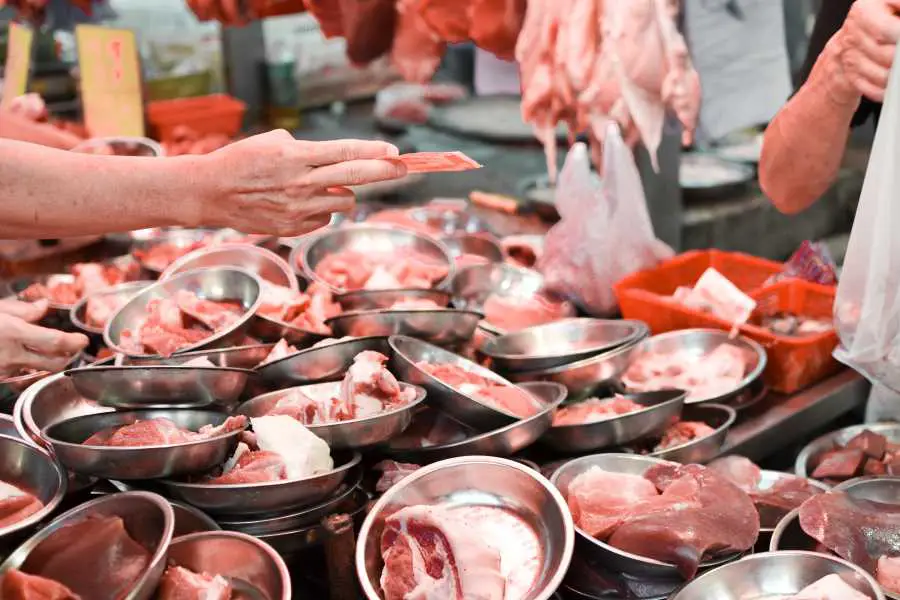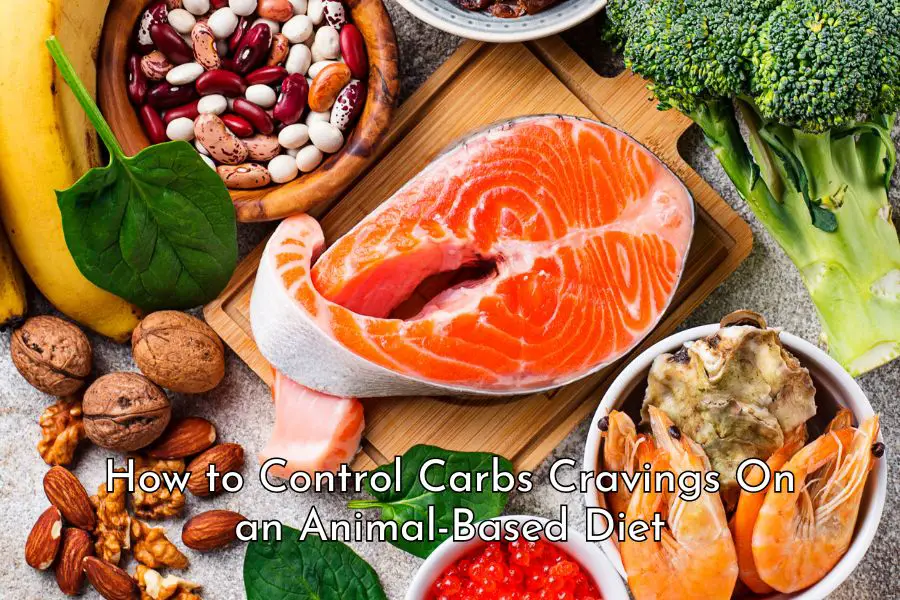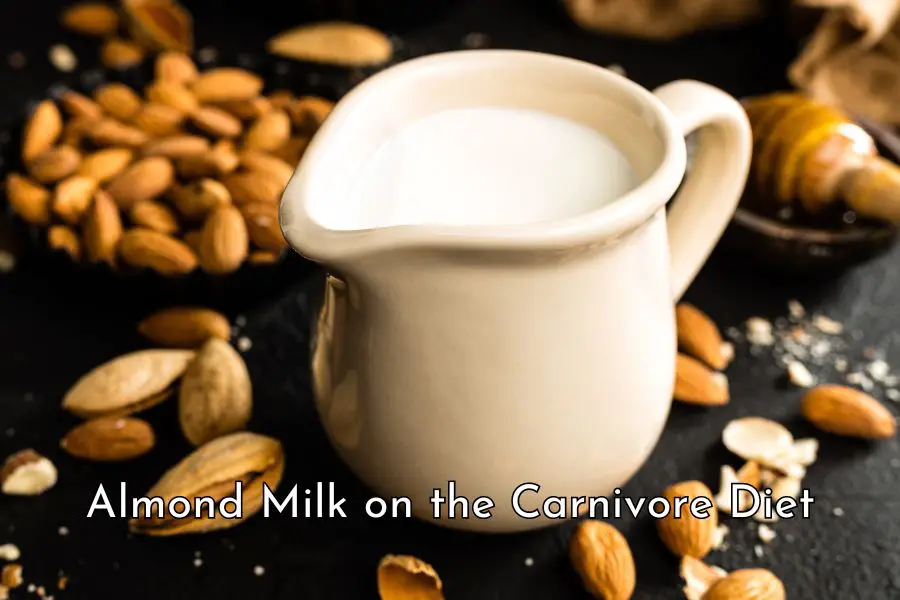If you are looking for a list of carnivore diet foods, this post is definitely for you. I have been in the same situation and done extensive research on this topic. This post hopefully will clarify any confusion you have about what best to eat on the carnivore diet.
Unlike many other carnivore diet food lists published elsewhere on the web, I won’t give you a list of foods and tell you what you should eat. Instead, I will go through the reasons why you should eat these particular foods on the carnivore diet.
It could be a bit winding but, generally, when you understand the whys, you will remember more and are more likely to make better choices in the long run.
However, if you just want a list, please click here.
Below, let’s look at what our ancestors ate for millions of years, what food choices we have today, and what best to eat given the available options.
What did our ancestors eat?
Our ancestors were definitely not generalist omnivores as previously widely believed. Instead, they were hyper-carnivorous apex predators that ate mostly meat from large animals for 2 million years, according to recent research led by Doctor Miki Ben-Dor and Professor Ran Barkai of Tel Aviv University.[1]
In a paper titled “The evolution of the human trophic level during the Pleistocene”, published in the Yearbook of the American Physical Anthropology Association, January 2021, and generated headlines around the world, the researchers identified 25 sources of evidence in total.
Together the evidence shows that, for 2 million years, humans were hyper-carnivorous that dined on the meat of large animals. Their diet was definitely not that of typical hunter-gatherer societies.
Only the extinction of large mammals due to extensive hunting led to a gradual increase of plant foods in the human diet and eventually led to the advent of agriculture and humans were forced to become farmers to survive.

Imagine living in the world of our ancestors back in those days. Together with your tribe, you would be moving about from one place to another, looking for food and eating whatever you could hunt or scavenge.
You might be feasting on a woolly mammoth for weeks and then an elephant or a couple of zebras or a rhinoceros. I don’t know, I’m just guessing. The point is you would have been eating a wide variety of healthy animals that roam freely in their natural environment.
When food was aplenty, you would eat just the most treasured parts of the animals. When food was scarce, you would eat everything, nose-to-tail, to survive. Sometimes the food would be eaten fresh, other times would be cooked.
In this post, I’ve discussed in detail how to eat healthily on the carnivore diet and listed five general principles that I believe you should follow. They are:
- Eat from a wide variety of animal sources to ensure sufficient nutrients. Eat meat (beef, lamb, goat, bison, pork, chicken etc.), seafood, eggs, bone marrow, bone broth, organ meat, butter, cream, yogurt, and tallow.
- Eat nose-to-tail or as many different parts of an animal as possible. Eating this way will respect the sacrifice of the animals, minimize waste while ensuring you have all the necessary materials you need to build a perfectly healthy human body
- Eat from naturally or well-raised animals as much as you can afford (e.g. grass-fed ruminants and pasture-raised pork and chicken)
- Eat unprocessed or minimally processed foods to preserve nutrients and minimize harmful additives
- Eat a mixture of cooked, lightly cooked or raw meat if it’s safe and you can tolerate because some nutrients can be destroyed due to prolonged cooking.
These principles basically try to emulate the way that our ancestors ate for millions of years which determines our genetic makeup to these days.
What food choices do we have today?
Fast forward to today, it is a totally different picture.
We don’t hunt or scavenge anymore. Instead, we go to the supermarkets, farmers’ markets, or the butchers and buy whatever’s on offer.
A few lucky ones may be able to afford and have access to good quality food from animals that have been raised well in their natural environment. If you were one of those, it would not be difficult for you to follow the healthy eating principles listed above.
However, for the majority of us today, it would mean buying meat from animals that are raised in conditions that are so far removed from their natural environment.
According to some estimates from animal rights groups, more than 90% of farmed animals worldwide live on factory farms.[2, 3, 4]
Whether you choose to believe their statistics or not, the percentage of animals raised in factory farms for human consumption is very high given the increase in living standards, higher demand, and the pressure to cut costs.
Let’s have a look at how these animals are actually raised in a factory farm environment.
Cattle[5, 6, 7, 8]
Beef cattle
Cattle raised for beef are the only factory-farmed animals that are still raised largely outdoors. This is likely due to their size and the fact that cattle are herbivores.
Cattle raised for beef graze on pasture until they are about 12 to 18 months old before being sent to a feedlot. They will spend about 4 to 6 months at the feedlot where they are fed a grain-based diet to accelerate weight gain.
Grass-fed beef cattle will spend their whole lives on pasture.
Grass-fed, grain-finished beef cattle generally remain on pasture but are supplemented with grains or are moved to a feedlot just a few weeks or a month for the finishing phase.
Dairy cows
Dairy cows at factory-farmed operations are mostly kept indoors and are housed in:
- Tie-stall barns, where cows are tethered to a stall
- Free-stall barns, where they can move around and have straw bedding areas to lie on
- Dry lots, which have no vegetation or bedding.
Milk production begins after the birth of a calf. Dairy cows are milked for 10 to 12 months, given a couple of months break, and then impregnated again for another cycle.
Dairy cows are given bovine growth hormone, a drug approved by FDA, to increase milk production. They are also given antibiotics to treat infections.
Pigs[9, 10, 11, 12, 13]
Pigs raised for meat in factory-farmed operations generally spend their entire lives in barren crates or concrete pens so small that they have no room to turn around. They do not have outdoor access. Sows spend their reproductive lives confined to a small gestation crate.
These pigs are fed a grain-based diet consisting of corn, soybean, wheat, barley, oat, and added vitamins and minerals. Because pigs are omnivores, I would say a 100% plant-based diet is unhealthy for them.
In the US, farmers are allowed to feed human food waste to pigs but in some countries like Australia and the United Kingdom, it is illegal to feed them products containing meat.
Pig feeds obviously affect pork quality and we will look at this issue in more detail in the next section. However, of note is the fact that pigs have single stomachs like humans and they can’t convert polyunsaturated fatty acids into saturated fatty acids and, as a result, pork is relatively high in polyunsaturated fatty acids compared to ruminant meat.
Furthermore, because these pigs are raised in unnatural barren environments, unable to socialize, explore and forage, they are stressed and aggressive abnormal behaviors like tail-biting are common. To fix this problem, piglets routinely have their tails and teeth trimmed off without anesthetics.
Pasture-raised pigs, on the other hand, are free to roam and will feed on what they can find on the pasture but are also provided supplementary feeds. They will eat bugs, insects, grass, fruit, seeds, roots, tubers, bulbs, and foliage.
Feral pigs will eat many things including small mammals, birds, reptiles, frogs, crayfish, eggs, earthworms and other invertebrates, and all parts of plants including the fruit, seeds, roots, tubers, bulbs and foliage.
Chicken[14, 15, 16, 17, 18, 19]
Chickens raised for meat
Chickens raised for meat are raised indoors in large sheds at a high density of around 20,000 to 30,000 birds per shed. These chickens usually don’t have access to the outdoors and are likely to spend their entire lives in the sheds.
They are excessively fed grains and oilseed meals or animal by-product meals for fast unnatural growth. These have a significant impact on the quality of the poultry meat produced and we will look at this issue later on in more detail.
Lights in those sheds are on most of the time to restrict their sleep and keep them eating and growing and, as a result, they are chronically sleep-deprived.
They are also given drugs to control parasites and low-dose antibiotics to prevent or treat diseases likely related to unhealthy living conditions.
Genetic selection results in these chickens’ extremely fast muscle growth but their bones, hearts, and lungs cannot keep up. A large proportion of these chickens have leg problems and can’t support their own weight due to unhealthy excessive growth. Being forced to squat in their own waste means other health problems follow like breast blisters, hock burn, and chronic dermatitis. Some can’t even move to reach food or water and will die of starvation or dehydration.
In 1925, it took 16 weeks to raise a chicken to 2.5 pounds (1.1 kg). Today, chickens weigh double that in just 6 weeks.
In 1957, the average growth period for a chicken to reach slaughter weight was 63 days. By the 1990s, it took only 38 days and the amount of feed required halved.
Chickens raised for eggs
If you have raised your own chickens for eggs, you will know that hens are incredibly private. They like to lay eggs in individual nest boxes in private areas. Once I found over 30 eggs in a pocket of leaves behind our garage. One of the hens had decided not to lay eggs in the nest boxes provided but out of sight of everyone else. Some of these eggs must have been laid over a month before I discovered them but all of them were in perfect condition.
The hens in factory farms, however, are grouped together in small cages. Up to 10 hens are put in one cage roughly the size of a file drawer. They eat, poop, and lay eggs in one unnatural place. Of course, they would still lay eggs but how stressful this unnatural environment would be for them. Their beaks, therefore, are trimmed at a young age to prevent abnormal pecking behaviors and cannibalism.
And of course, like the chickens raised for meat, hens are fed and drugged in a similar way to maximize egg production.
A hen in a factory farm produces, on average, about 320 eggs over her life span of about 72 weeks, compared to about 4 years for a pasture-raised hen that is allowed to lay eggs in a more natural way.
Pasture-raised chickens
Pasture-raised chickens spend their time outdoors during the day and only go indoors at night to sleep. As a result, they feed on whatever they can find in the pasture.
Being omnivores, they will eat insects, bugs, grubs, grass, and whatever else they can find. Interestingly, they certainly prefer meat over plant foods! If you throw them kitchen scraps that have some fat trimmings and vegetables, they will definitely fight over the fat trimmings rather than the vegetables.
Pasture-raised chickens are given supplementary feed because it is unlikely to be economical if they are left to live off the pasture foods only. However, pasture-raised eggs are of superior quality compared to caged chickens because:
- they get a wide variety of foods from the natural environment
- they are a lot more healthy given the free outdoor access
- they are a lot happier.
Fish[20, 21, 22]
It is estimated that today about half of all fish consumed worldwide are farmed.
Similar to pigs and chickens, farmed fish are crammed in small enclosures that there isn’t much room for them to swim about.
For example, salmons are housed in cages with 5,000 to 50,000 fish each. They are treated with antibiotics and routinely injected vaccines.
Their feed includes wild fish supplemented with vegetables, chicken, and other land animals. Due to the difference between their diet in the wild and what they are fed in aquafarms, the flesh of salmon turns grey color and so farmers use the colorings astaxanthin and canthaxanthin to dye flesh pink. Canthaxanthin has been linked to retina damage in humans.
Other fish like rainbow trout, Atlantic Halibut, Atlantic cod all have drugs, chemicals, and pollutants in them.
Summary
Overall, factory farming is definitely not a pretty picture, to say the least.
Animals everywhere are suffering to serve humans.
If we could choose to eat plant-based foods and remain healthy, I’m sure most of us would make that choice. I had tried to follow a mostly plant-based diet before believing it was healthy, but my body didn’t agree with me.
We evolved from a heavily meat-based diet and that is a fact. If lions are forced to turn into herbivores, or zebras are forced to become carnivores, these species will be wiped out. And humans suffer serious health consequences when we eat a diet that we are not meant to eat.
I think it would be helpful to separate the two arguments: what foods are healthy for us and how can we produce those foods in an ethical manner that is good for the environment in the long term.
For humans, based on the available evidence, a heavily meat-based diet is what we are meant to eat, full stop. The question then is how we can raise animals in an ethical way and give them a good life before they have to sacrifice for human consumption. Every living thing dies at some stage, the key question is the quality of life, but this is a big topic that is outside the scope of this post.
However, I think it would be conflating the two separate arguments and illogical to say that: because most animals are raised in horrible conditions to make foods for humans, we should eat plants instead and seek evidence to prove that a plant-based diet is healthy.
What are the best carnivore diet foods?
Prioritize grass-fed, pasture-raised or wild-caught animals
Given what we know about how cows, pigs, chickens, and fish are raised for meat, eggs, and dairy, it is obvious that, if you have the means, it is a no brainer that you should buy produces from grass-fed, pasture-raised or wild-caught animals as much as you can. That means eating the following foods:
- Grass-fed beef + organs + bones
- Grass-fed lamb + organs + bones
- Pasture-raised pork + organs + bones
- Pasture-raised chicken + organs + bones
- Pasture-raised eggs
- Grass-fed milk, especially raw milk if you have access to safe raw milk and can tolerate
- Other grass-fed, wild-caught animal source foods (bison, deer, kangaroos, and other wild games).
This is supported by the nutrient data shown below.
Table 1 – Nutrients of grass-fed beef, grain-fed beef, wild-caught salmon and farmed salmon[23]
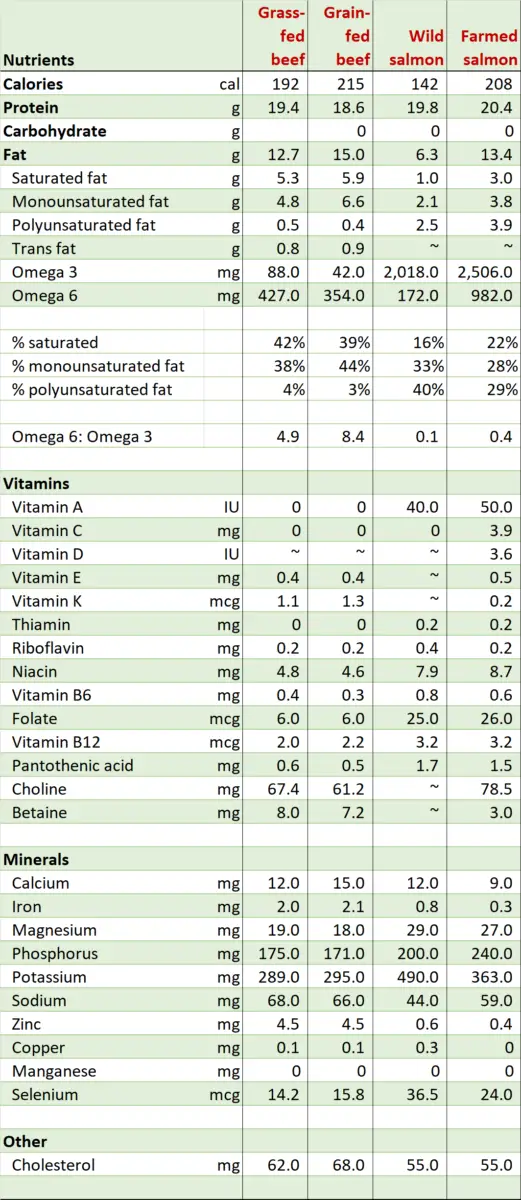
The key differences between grass-fed and grain-fed beef and wild-caught salmon and farmed salmon are in their better fat contents:
- Grass-fed beef has 12.7 grams of fat per 100 grams compared to 15 grams per 100 grams for grain-fed beef
- Wild-caught salmon has only 6.3 grams of fat per 100 grams compared to 13.4 grams of fat per 100 grams for farmed salmon
- Grass-fed beef has a lower omega 6 to omega 3 ratio of only 4.9 compared to 8.4 for grain-fed beef
- Wild-caught salmon has an omega 6 to omega 3 ratio of 0.1 compared to 0.4 for farmed salmon.
Although some argue that grass-fed beef and wild-caught fish also have better vitamin and mineral contents than farmed counterparts, that is not what we see in the above data. There isn’t a huge difference in these nutrients between grass-fed and grain-fed beef and between wild-caught and farmed salmon based on the available USDA data.
However, remember that cows that spend their entire lives living in their natural environment and eating a species-appropriate diet will be more healthy and less likely to be injected with hormones to stimulate growth or drugs to treat diseases.
Similarly, wild salmon will eat their natural diet of wild fish and are free to swim in the ocean, while farmed salmons are housed in crowded cages, eat an unnatural diet, are fed antibiotics, injected with vaccines, and are dyed pink to look appealing to consumers.
Although I can’t find full nutritional data on pasture-raised pork and pasture-raised chickens and pastured eggs, some limited data available show that they are expected to be nutritionally superior compared to farmed counterparts:
- Tests done on pasture-raised eggs have found that they have:[24]
- 1/3 less cholesterol
- 1/4 less saturated fat
- 2/3 more vitamin A
- 2 times more omega-3 fatty acids
- 3 times more vitamin E, and
- 7 times more beta carotene compared to caged eggs
- I can’t find full nutritional data on pastured pork. However, a small study has found that pasture-raised pork have much better omega 6 to omega 3 ratios compared to factory-farmed pork. In particular:[25]
- conventional factory-farmed pork’s ratio was 29:1
- pasture-raised pigs fed with grains’ ratio was 14:1
- pasture-raised pigs fed with 50% reduced grains’ ratio was 10:1
- pasture-raised pigs fed no grains at all was an impressive 5:1.
If you are in the US, you’d be lucky because you can have access to bison which is always 100% grass-fed and free from antibiotics and hormone treatments. Similarly, in Australia, you can get kangaroo meat which is 100% grass-fed, free from drugs, and is usually more affordable than beef.
Prioritize ruminant meats if you can’t afford grass-fed, pasture-raised or wild-caught animals
Unfortunately for most of us, having to consume factory-farmed meat is the reality that we live in. If you are amongst those and choose to follow the carnivore diet for whatever reasons, the best foods to eat are those from ruminants like cows, sheep, and goats because:
- They are raised the best amongst farmed animals. As described above, cows are still largely raised outdoors and allowed to graze for part of their lives before being fed grains during the finishing phase. In contrast, most farmed pigs and chickens spend their entire lives indoors and are fed a diet that is vastly different from their natural diets
- Their nutritional profiles are also better than that of pork and chicken as shown below.
Table 2 – Nutrients of ground beef, ground lamb, ground pork, ground chicken and farmed salmon[26]
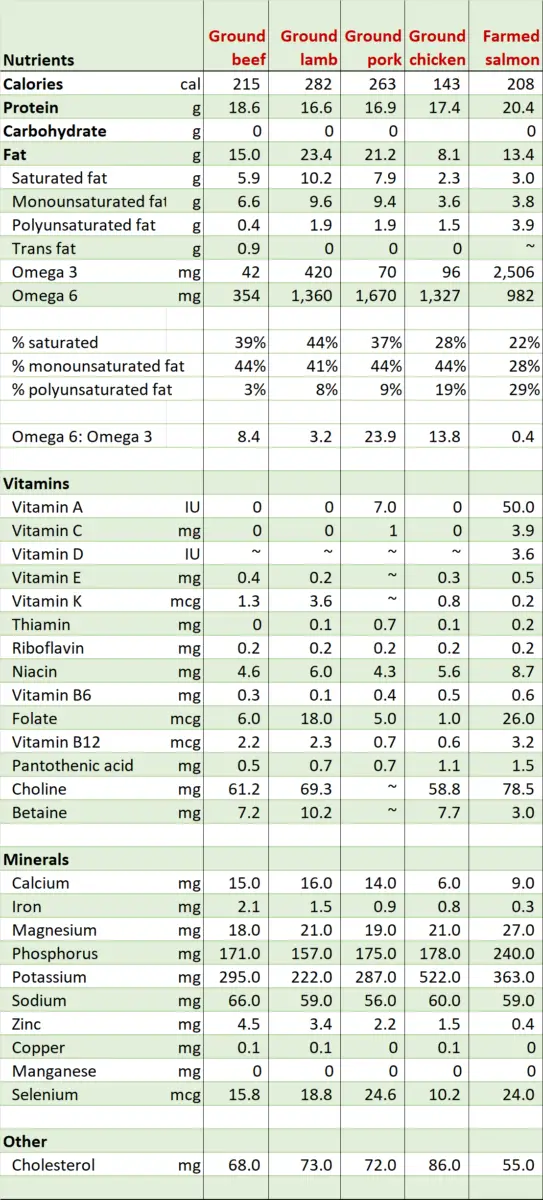
Looking at the above data, the main differences between ruminant meat and pork and chicken are their fat contents.
Remember you could get different results for different batches of meat tested.
For these particular samples tested by USDA, ground beef and ground lamb have 15 grams and 23.4 grams per 100 grams respectively, consistent with the fact that lamb is generally known to be fattier than beef. Ground pork and ground chicken have 21.2 and 8.1 grams per 100 grams respectively, consistent with the fact that pork is generally known to be fattier than chicken.
Beef and lamb have a lower level of polyunsaturated fats (at 3% and 8% respectively) compared to pork and chicken (at 9% and 19% respectively).
Their omega 6 to omega 3 ratios are also lower, 8.4 and 3.2 compared to 23.9 and 13.8 for pork and chicken respectively.
The reason why this makes beef and lamb a better choice is the skyrocketing in the consumption of polyunsaturated fats, in particular, omega 6 fatty acids in the US has been linked to many modern-day health problems.
While our hunter-gatherer ancestors are thought to have consumed omega 6 and omega 3 in the ratio of approximately 1:1, in the US, current intake data indicate that this ratio has blown up to approximately 10:1.[27]
Therefore, your staple food on the carnivore diet should be ruminant meat like beef, lamb, goat, bison and deer. If you would like pork and chicken for variety, preference or budget constrain reasons, you should choose lean pork and lean chicken.
As can be seen in the table below, although lean pork and chicken still have poor omega 6 to omega 3 ratios, their total fat contents are low. Lean pork has only 2.5 grams of fat per 100 grams and lean chicken has only 3.9 grams of fat per 100 grams.
Table 3 – Nutrients of lean beef, lean lamb, lean pork and lean chicken[28]
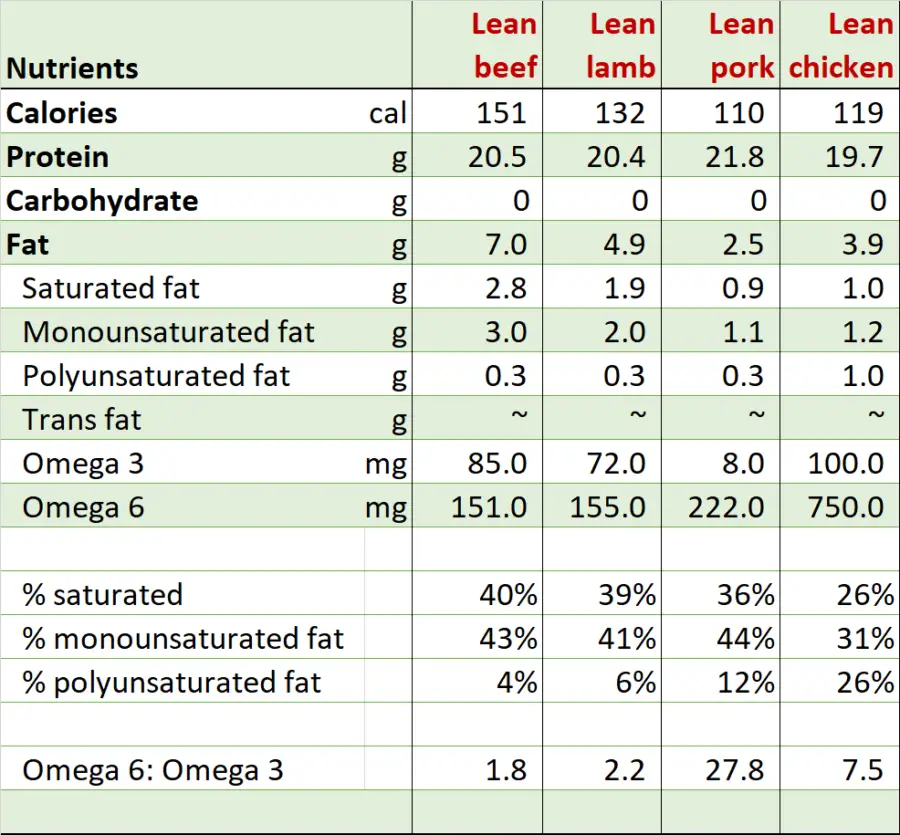
If you need animal fat for cooking on the carnivore diet, the best type of fats is also ruminant fats as can be seen in the table below.
Table 4 – Nutrients of beef fat, lamb fat, butter, lard and chicken fat[29]
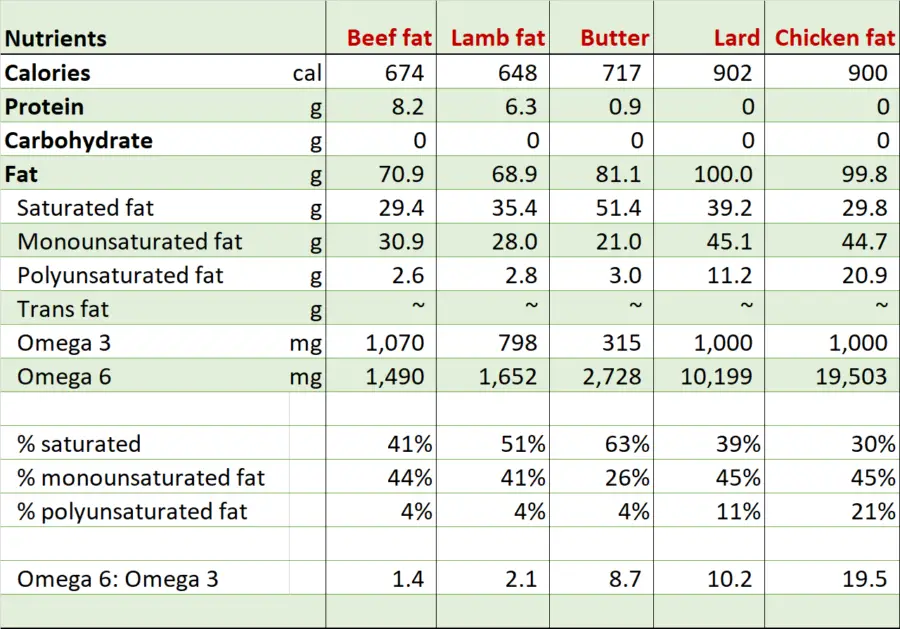
Your ultimate carnivore diet food list
In summary, if you can afford to pay for grass-fed, pasture-raised, wild-caught animal source foods, life is a bit more simple on the carnivore diet. All you have to do is to follow the five healthy eating principles that I have set out in detail in this post: eat a variety of foods, eat nose-to-tail, eat foods from well-raised animals, eat unprocessed and eat a combination of cooked, lightly cooked and raw foods.
Even if you’re constrained by a budget like many of us are, choose grass-fed, pasture-raised, wild-caught sources whenever you can, even that means having to buy your less favorite cuts, offcuts, bones, or organ meats that you are not familiar with. Producing good quality meat while looking after the welfare of the animals is an expensive business. By eating nose-to-tail and not wasting anything, we help those farmers and pay our respect to the animals that have to sacrifice their lives for us.
If you can’t afford grass-fed, pasture-raised, wild-caught animal source foods, still try to follow these five principles, however:
- Your staple food on the carnivore diet should be ruminant meats like beef, lamb and goat. If you can have access to bison and kangaroo, they are great too and personally, I would choose those over conventionally farmed beef, lamb, and goat
- If you like to add pork and chicken for variety, choose lean cuts of these meats and add in ruminant fats which are currently very affordable
- Have a small amount of ruminant organ meats such as liver, heart, kidney, tripe, oxtail on a regular basis. If you are concerned about the high level of vitamin A in liver, please read this post to see how much liver you can have safely in a day
- Make and drink bone broth regularly and have a couple of pieces of bones a day for calcium especially if you can’t tolerate dairy
- Have seafood once or twice a week. If you can’t afford fresh wild-caught seafood, I would rather choose canned wild-caught seafood over fresh farmed seafood. Canned fish with bones in is also a great source of calcium
- Have eggs regularly if you like. Although farmed eggs have a poor omega 6 to omega 3 ratio compared to ruminant meat, their fat content is relatively low
- Have dairy occasionally for calcium if you can tolerate dairy products.
Below is a summary table that you can print out and stick on your fridge for easy reference.
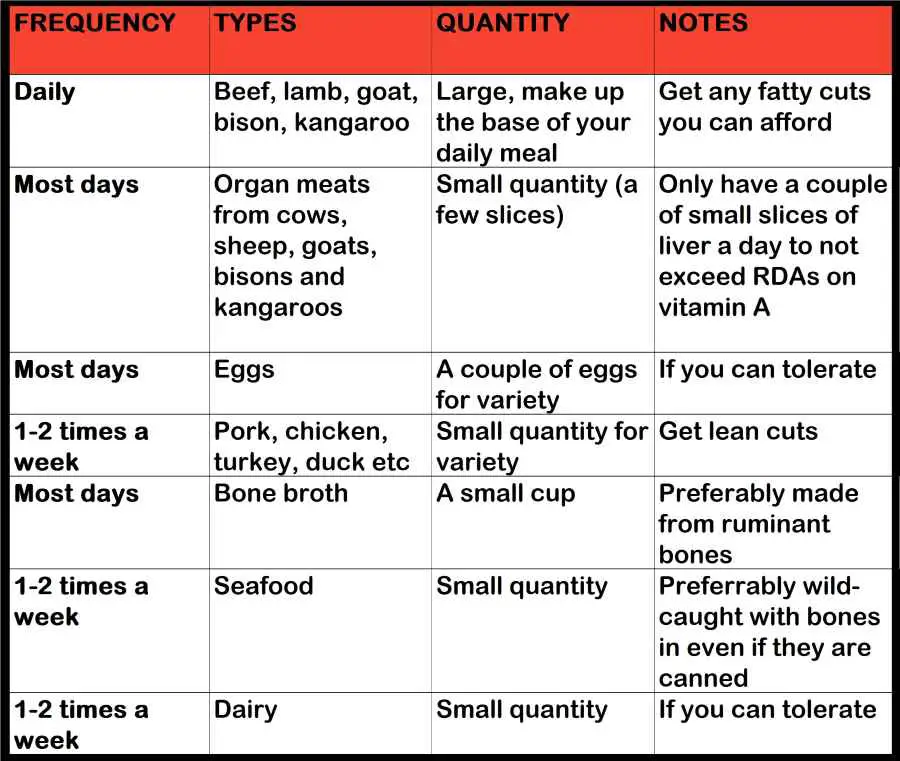
Disclaimer: The information in this post is for reference purposes only and not intended to constitute or replace professional medical advice. Please consult a qualified medical professional before making any changes to your diet or lifestyle.

